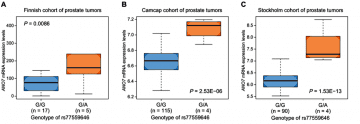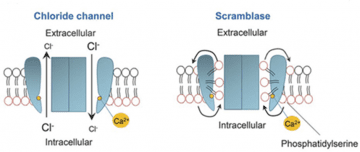ANO7 gene and aggressive prostate cancer
ANO7 gene and aggressive prostate cancer
In our original sequencing analysis of CRPC (castration resistant PrCa) tumors, we found recurring ANO7 variants, two of which had clear disease relevance. Recently, we reported12 that ANO7 variant rs77559646 showed both risk (OR 1.40; p=0.009, 95% CI 1.09–1.78) and association with aggressive PrCa (Genotype test p=0.04). It was also found to be an eQTL for ANO7. SNP rs148609049 was not found to be associated with risk, but was related to shorter survival (HR 1.56; 95% CI 1.03–2.36). High ANO7 expression was independently linked to poor survival (HR 18.4; 95% CI 1.43–237). Further, ANO7genotypes correlated with expression and biochemical relapse, suggesting that ANO7 is a potential PrCa susceptibility gene and that its elevated expression correlates with disease severity and outcome.

The risk genotype G/A of rs77559646 was significantly associated with increased mRNA expression of ANO7. The ANO7 mRNA levels were examined with RNA-seq and displayed as RPKM values in a collection of 22 prostate cancer samples (Turku Prostate Cancer Consortium treatment cohort) (A), and by Illumina Expression BeadChip-based transcriptional profiling in a collection of 119 (B) and 94 (C) human prostate tissue samples9 (levels are log2 transformed and quantile normalized) (Kaikkonen et al., ANO7 is associated with aggressive prostate cancer. Int J Cancer, 143(10):2479-2487, 2018).
ANO7 (TMEM16G, NGEP [New Gene Expressed in Prostate]) belongs to the anoctamin family of Ca2+-activated Cl− channel proteins with altogether ten members (ANO1-10), many of which also have scramblase activity. The family members show tissue specific expression patterns and have differing roles in physiology and pathophysiology. ANO7 is almost exclusively expressed in prostate tissue. The chromosomal location of ANO7, 2q37.3, was originally detected by us in genetic linkage studies and later also in GWAS analyses as a high risk PrCa region. The precise structure and function of human ANO7 is unknown, but scramblase activity has been demonstrated in the mouse ortholog. ANO7 gene has two isoforms: ANO7-L (long) with 25 exons and ANO7-S (short) consisting of exons 1-4, exon 4 extending into the downstream intron.

In our current ongoing projects, we continue the basic characterization of ANO7, and investigate the function of the risk SNPs. Much of the data points to changes in splicing.